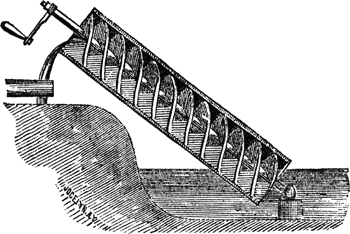
The Daily Mail just ran a nice story saying that one of Archimedes' best known inventions is being adapted to produce green electricity.
The "Archimedes screw" consists of a screw inside an angled tube - as the screw turns, it lifts water up through the tube (see pic below). The mathematician, who worked in Syracuse, Sicily, in the third century BC, is supposed to have invented it to drain water from the hulls of ships, and it is still one of the most efficient ways we know of transferring large volumes of water. The screws are still widely used, from low-tech crop irrigation in regions such as Egypt's Nile Delta, to state-of-the-art flood defence schemes.
Green engineers have now reversed the principle for use in a small hydroelectric plant in the Yorkshire Dales. Water flowing through the River Wharfe will fall down two Archimedes screws, turning the screws and driving turbines. Hydroelectric dams are usually huge multimillion pound projects that require powerful flows of water. But this set-up should allow electricity to be generated from rivers on a much smaller scale. According to the Mail, the two 12-metre-long screws will generate 510,000 kilowatt hours of green electricity per year, enough to power 100 houses.
Also in the news last week was an even more futuristic use for the Archimedes screw. Discovery News reported that scientists are aiming to use the principle to create a replacement human heart. Instead of building a heart that beats, a pump based on an Archimedes screw would drive blood around the body at a constant rate. Such pumps are already used to help out weak hearts, and have been implanted in more than 1600 patients since 2003. But researchers from the Texas Heart Institute and the University of Houston now plan to use the technique to replace failing hearts completely. It'll take many years of studies before they're ready to do it though, not least to work out whether there are any long-term adverse effects of not having a pulse.
By the way, the Archimedes screw should not be confused with another of the great man's inventions, the "endless screw" (yes that really is its name). In this gadget, a threaded screw is used to engage a toothed wheel with a much larger gear ratio, meaning that a lot of gentle winding turns the wheel a small distance, but with a much stronger force than that originally applied by the winder. According to the ancient historian Plutarch, such a device allowed Archimedes to impress Syracuse's king by single-handedly dragging a ship over the ground, "as smoothly and evenly as if she had been in the sea".
This sounds like a bit of an exaggeration - Plutarch was writing a few hundred years later after all. But the fact that Archimedes was playing around with gearwheels and force ratios add support to the idea that he might have been the first person to develop mathematical gearwork of the type used in the Antikythera mechanism.